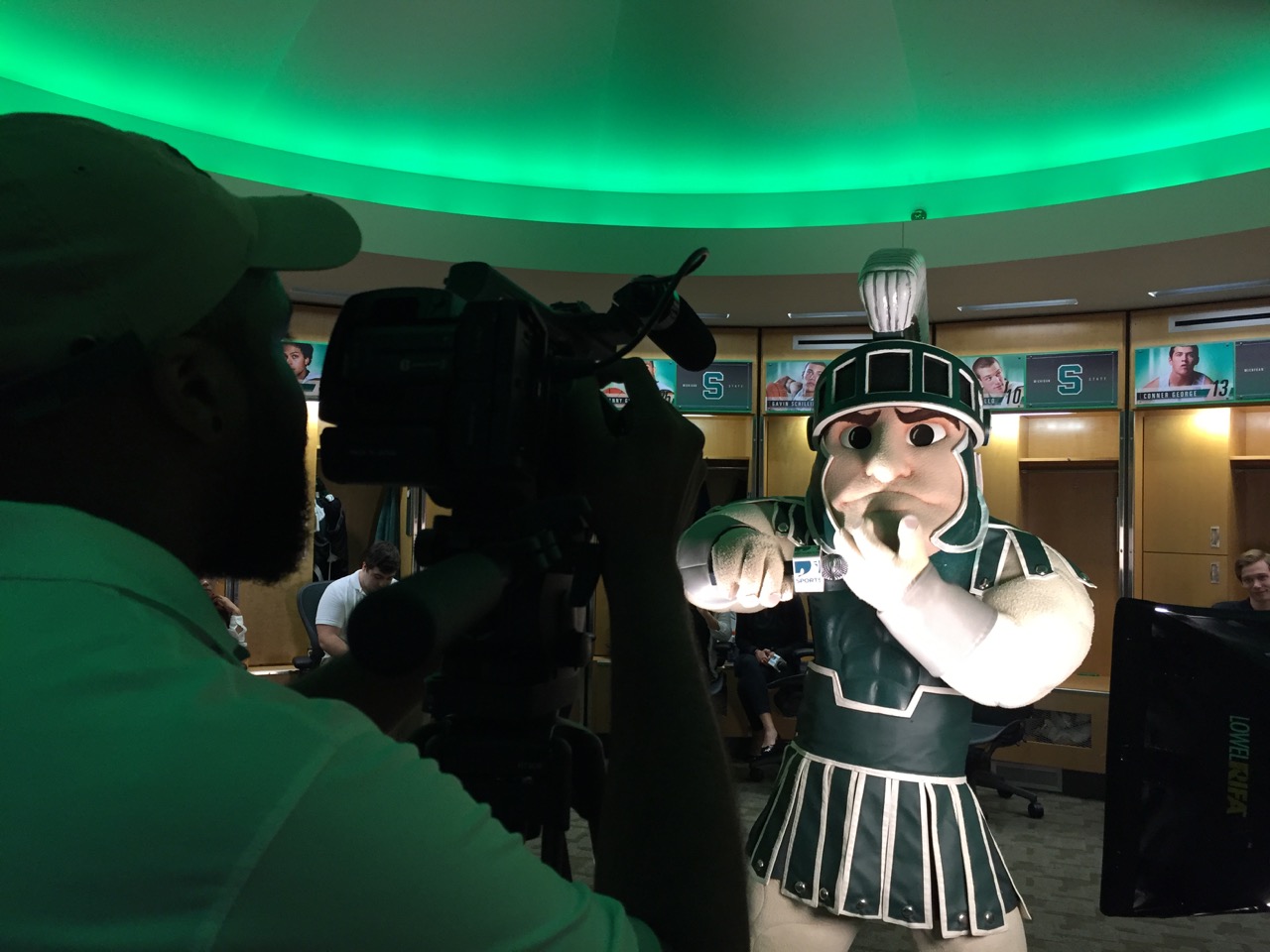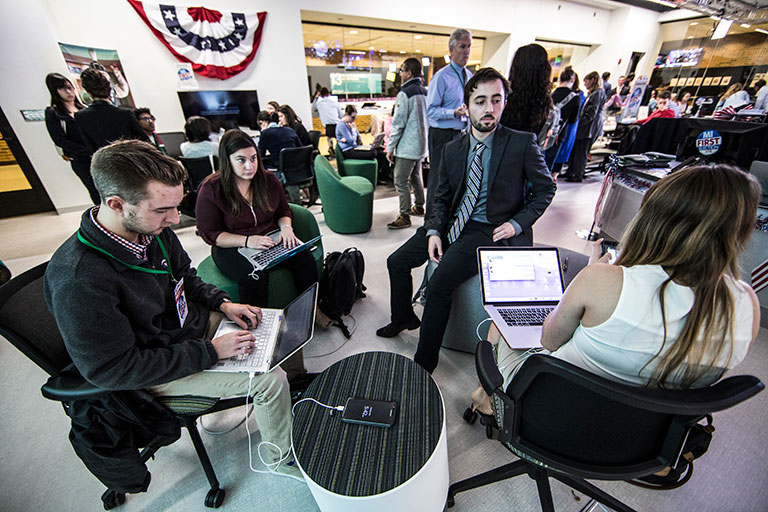How the MSU's J-School Is Preparing Students for the Future of Journalism
Creativity, critical thinking and an entrepreneurial spirit come together at the MSU School of Journalism, where students are training to become the storytellers of the future.
“The media keep evolving and changing,” said MSU School of Journalism Director Tim Vos, Ph.D. “There’s always a need for good journalism, and that’s what we have to prepare students for. We have to be nimble to be able to meet those needs in new, different, and innovative ways.”
While traditional media still play a key role in informing the public, these legacy news outlets have become part of a larger multimedia equation that encompasses a range of information outlets and platforms. Not only is news distributed on social media, but it also finds its way to the public through emerging technology and start-up enterprises.
“Storytelling is a digital enterprise these days,” said Vos. “We want the students to be digital storytellers and that means across multiple platforms and in various modes of presentation.”
Honoring History, Preparing for the Future
“The MSU School of Journalism is well-regarded, and it’s highly ranked,” said Bruno Takahashi, Ph.D., associate professor and co-director of journalism graduate studies.
The MSU School of Journalism offers students the longest running accredited journalism program in the U.S., having been continuously accredited since 1949. One of the oldest programs in the nation, the first course was taught in 1910.
“We are respectful to our history,” said Vos. “The tradition lives on. We’re still educating students in traditional journalistic disciplines. Now, we are really trying to think about the future of journalism and build that into our program. We’ll be growing our capacity as a program in digital storytelling, which means being adept at dealing with data and being adept at visual communications, in terms of design, photography, video, and so on.”
MSU’s journalism faculty range from academic experts and renowned researchers to professional journalists, with many Pulitzer Prize and Emmy Award winners teaching in the classroom. In 2020, six new faculty joined the ranks, bringing their expertise in documentary and filmmaking.
Giving Spartans a Competitive Edge
“Journalists have to be creative. Journalists have to be critical thinkers,” said Vos. “We see this as really important parts of the journalism experience and what makes our journalism students really succeed.”
Through the coursework at ComArtSci, students get training in both critical thinking and creativity. While college students are often expected to have these qualities, MSU’s faculty go above and beyond, offering students training in the processes used to develop critical thinking and to think outside the box. This lets students use those processes for years to come, in place of learning by mistake.
“A course that we teach early on in our program is Video Storytelling with Phones,” said Vos. “Everyone carries a digital storytelling device with them. This allows every student journalist to be ready to produce a news story.”
To his knowledge, MSU is the only university to offer such a course. In the class, students learn the basics of reporting and storytelling while using smartphone techniques and high-level skills to create polished video presentations. Watch Phoning It In.
“We’re using this course to get our students in the reporting process way earlier than what you would normally do, because there’s a big learning curve to use a lot of the technology,” said Vos. “To learn the principles of storytelling, and the principles of visual storytelling, early on in the program really moves our students along further, and it allows them to reach a higher level by the time they’re out in the field.”
Training the Storytellers of Tomorrow
No matter what aspect of journalism they’re interested in, students will find a place where they belong in the MSU School of Journalism. The school is home to the vibrant Newsroom, a production studio that bustles with activity during elections, as well as a wealth of opportunities on campus, from productions like Focal Point and Spartan TV, to print publications and The Impact. The school is also home to the Knight Center for Environmental Journalism, and it gives students access to Big Ten sports.
“We have a really strong sports journalism program,” said Vos. “For a program of our size, it’s really phenomenal.”
Students have access to state-of-the-art technology, including brand new equipment for broadcast journalism and cameras designed for 360 Video and immersive storytelling. A type of emerging media, immersive storytelling projects can involve anything from interactive photography to multimedia visual communications, animation, and film.
“We’re in the early stages of immersive storytelling right now,” said Professor of Practice Judy Walgren, who has won the Pulitzer Prize for photography. “I feel like we’re just standing on the edge of all the possibilities.”
“The issue facing journalism is that you used to be able to go and get essentially all of the audiences from a couple of places — broadcast, print, radio and tv, and newspapers,” said Vos. “Now, that audience is disbursed on so many different platforms. We want to have students prepared for all of those platforms and the platforms of tomorrow.”
Whether students are interested in writing, graphics, photography, video or comics, they’ll be able to pursue their preferred method of storytelling.
“What we’re beginning to see, too, is each one of those platforms has their affordances for doing a kind of journalism, and which also sort of suggests that those kinds of journalism aren’t going to go away,” said Vos. “They function in a way that facilitates a certain kind of storytelling.”

Spartans Will Be Agents of Change
Through the Journalism M.A. program and the Ph.D. in Information and Media at MSU, graduates can take their journalism studies even deeper. The master’s program brings research faculty directly to students to share current projects and invite collaboration on faculty research. The graduate program is also one of the few journalism programs to offer an academic track.
“There are going to be quite a few changes in terms of the structure of the journalism programs,” said Takahashi. “Starting in the fall, we’ll have a new core of classes.”
A new curriculum is slated to begin in the fall semester, offering a range of courses that will ground students in the foundations of journalism and prepare students to manage disruption when they enter the profession. Faculty will share their insight into the future of media through a course on disruption and change in journalism.
“That’s a really important course for us, and one that really makes it an intellectually exciting discipline to be a part of,” said Vos. “It’s a course that will be taught differently every year based on what is changing or what is disruptive, but it’s also to acknowledge that journalism has always been changing.”
The course allows Spartans to witness what changes in journalism day by day, and to draw insights from those changes that inform their education and professional training.
To put contemporary change into context, Vos said, it helps to know the history of journalism and the changes that have occurred over time. History also explains why journalism is sometimes slow to change.
“Our faculty do a really impressive job of staying on top of the changes in the field,” said Vos. “We want students to be agents in that change.”
In the programs, Spartans are also encouraged to become advocates of journalism.
“Journalists also need to be equipped to be advocates of the profession, and in the process, help improve the profession,” said Vos.
By Melissa Priebe
